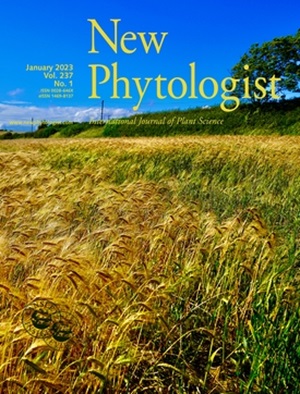转录组学揭示了一种生态位防御机制:两种有益的根内生菌利用抗菌素 GH18-CBM5 几丁质酶来保护宿主。
IF 8.3
1区 生物学
Q1 PLANT SCIENCES
引用次数: 0
摘要
效应物分泌对于根内生菌建立和保护其生态位至关重要。我们利用时间分辨转录组学监测了两种亲缘关系很近的Sebacinales--Serendipita indica和Serendipita vermifera--在与三种植物共生、与植物病原真菌Bipolaris sorokiniana竞争以及与根相关细菌合作过程中效应基因的表达动态。我们观察到效应基因在生物相互作用(尤其是与植物的相互作用)中的表达增加,这表明它们在宿主定殖中的重要性。一些效应基因对植物和微生物都有反应,这表明它们在微生物间竞争和植物与微生物相互作用中具有双重作用。包括 GH18-CBM5 几丁质酶在内的推定抗微生物效应子集只由微生物诱导。对这种几丁质酶的功能分析显示了其抗菌和保护植物的特性。我们的结论是,动态效应基因表达支持了丝囊菌在不同生态位中繁衍生息的能力,其中一种真菌几丁质酶对生态位防御做出了重大贡献。本文章由计算机程序翻译,如有差异,请以英文原文为准。

Transcriptomics reveal a mechanism of niche defense: two beneficial root endophytes deploy an antimicrobial GH18-CBM5 chitinase to protect their hosts
求助全文
通过发布文献求助,成功后即可免费获取论文全文。
去求助
来源期刊

New Phytologist
生物-植物科学
自引率
5.30%
发文量
728
期刊介绍:
New Phytologist is an international electronic journal published 24 times a year. It is owned by the New Phytologist Foundation, a non-profit-making charitable organization dedicated to promoting plant science. The journal publishes excellent, novel, rigorous, and timely research and scholarship in plant science and its applications. The articles cover topics in five sections: Physiology & Development, Environment, Interaction, Evolution, and Transformative Plant Biotechnology. These sections encompass intracellular processes, global environmental change, and encourage cross-disciplinary approaches. The journal recognizes the use of techniques from molecular and cell biology, functional genomics, modeling, and system-based approaches in plant science. Abstracting and Indexing Information for New Phytologist includes Academic Search, AgBiotech News & Information, Agroforestry Abstracts, Biochemistry & Biophysics Citation Index, Botanical Pesticides, CAB Abstracts®, Environment Index, Global Health, and Plant Breeding Abstracts, and others.
 求助内容:
求助内容: 应助结果提醒方式:
应助结果提醒方式:


